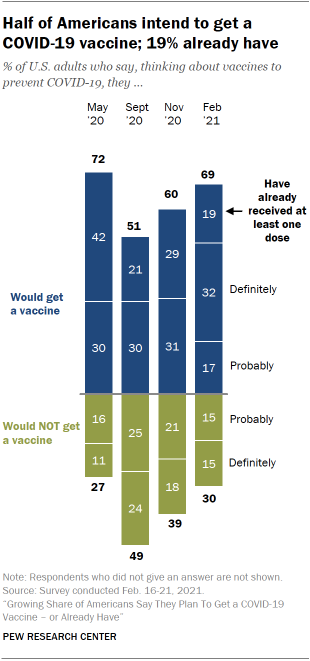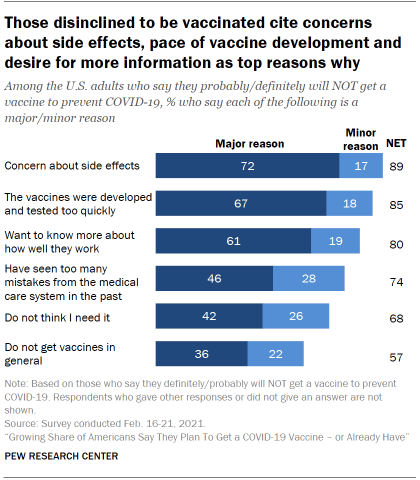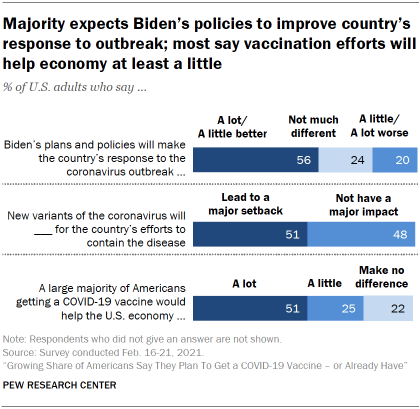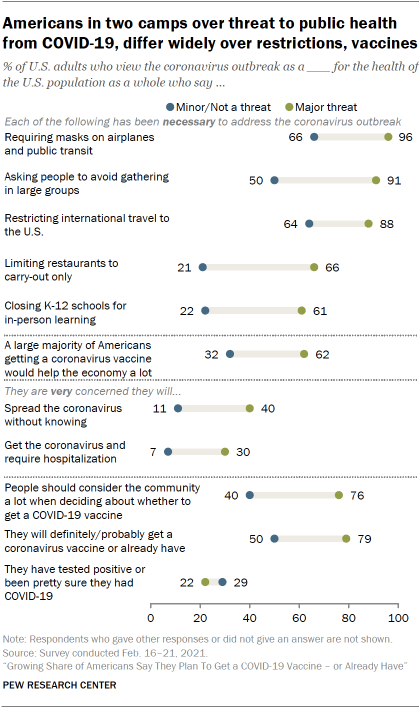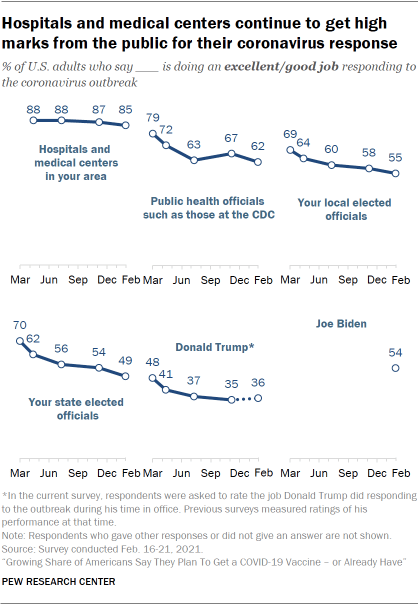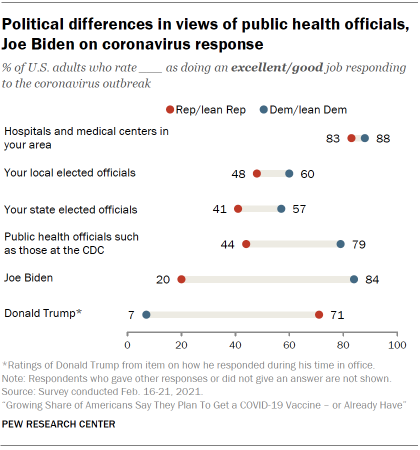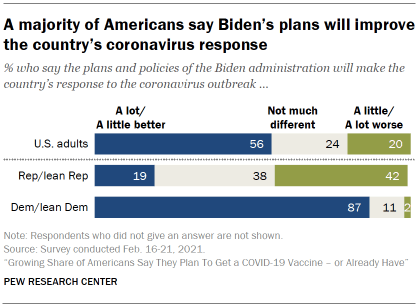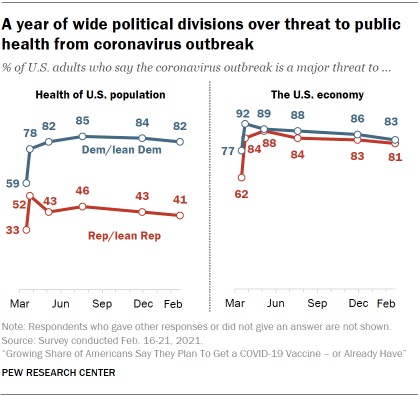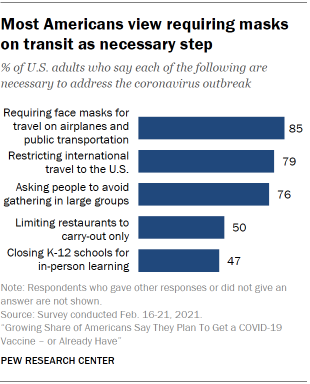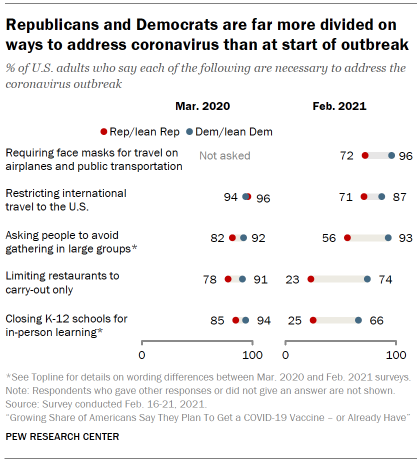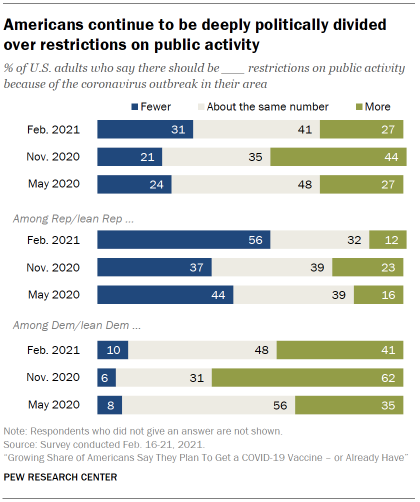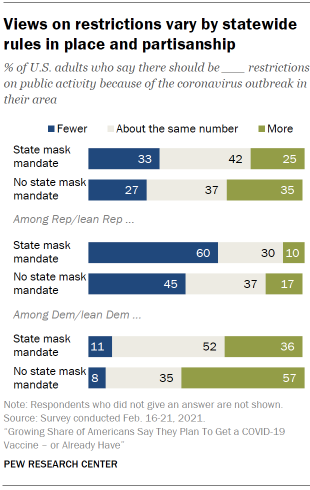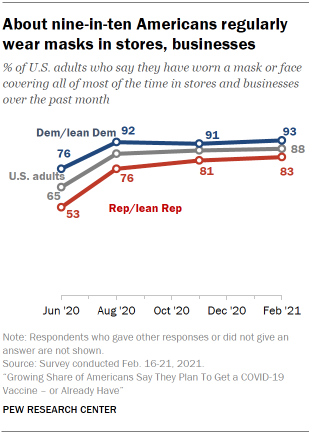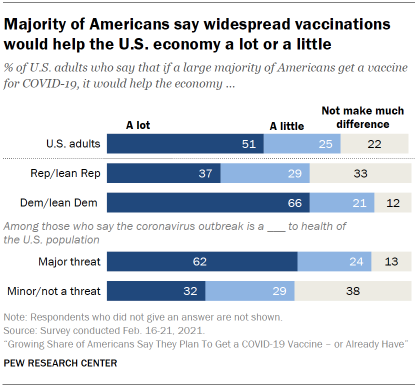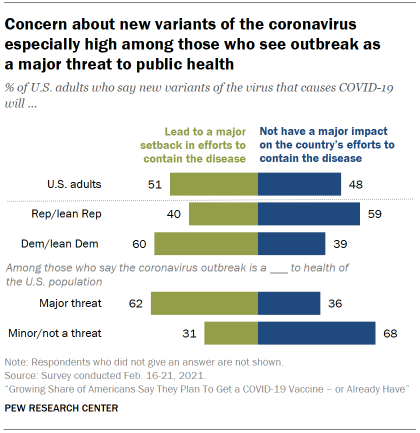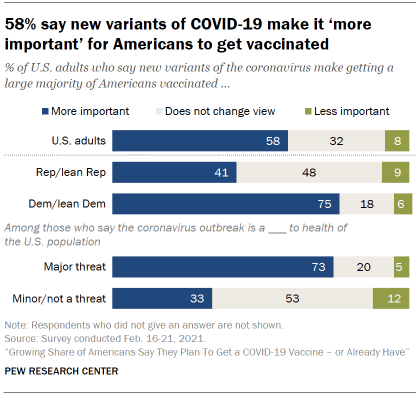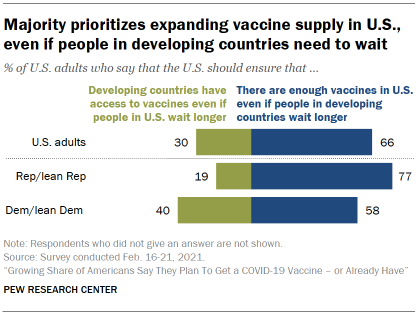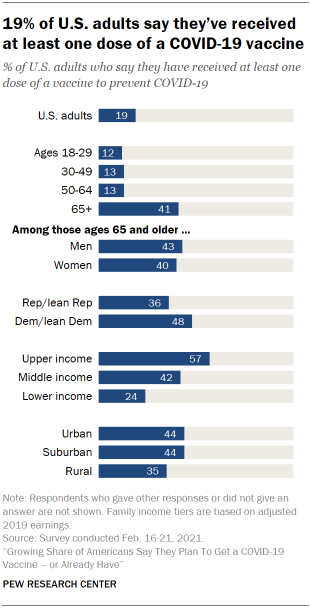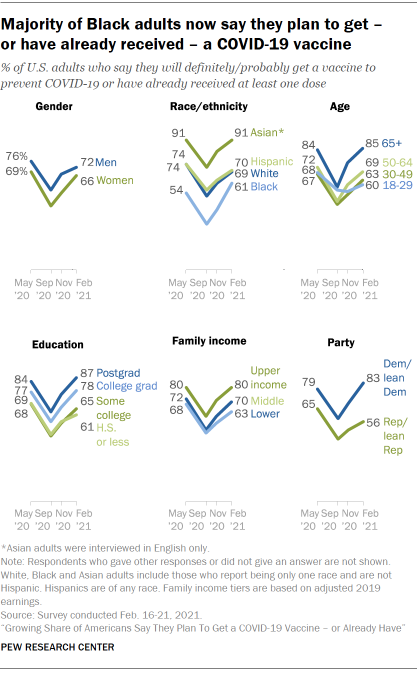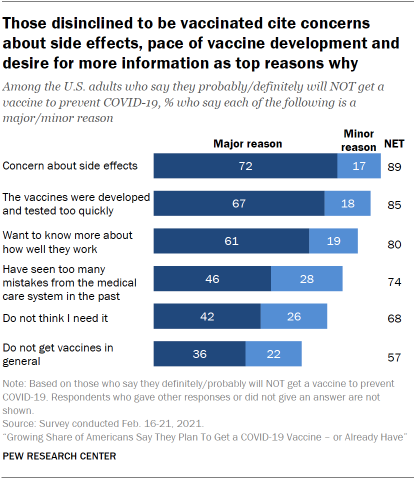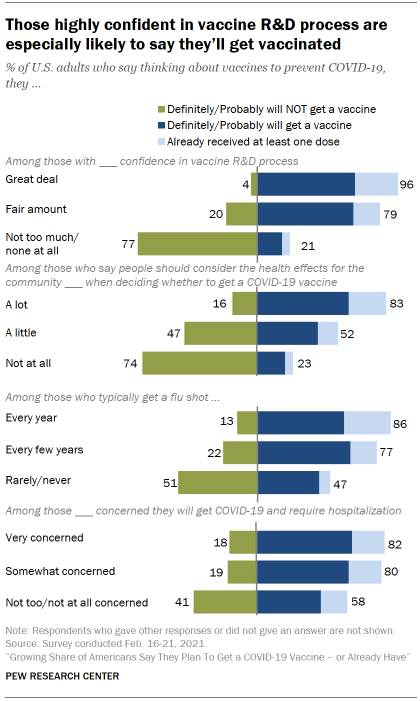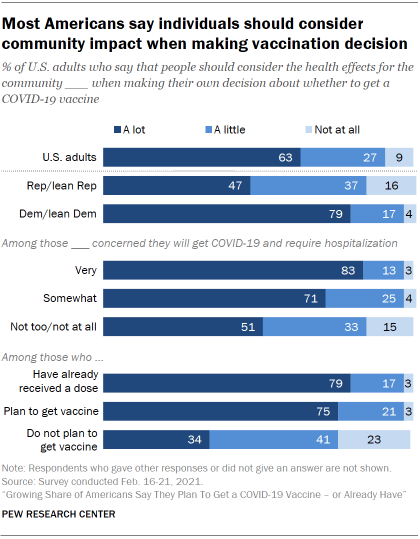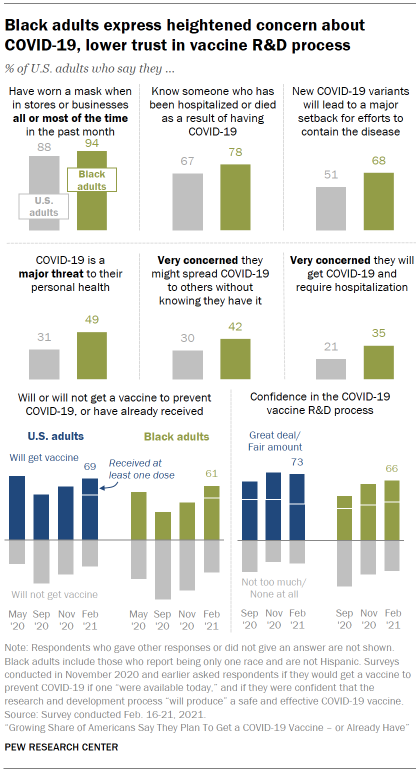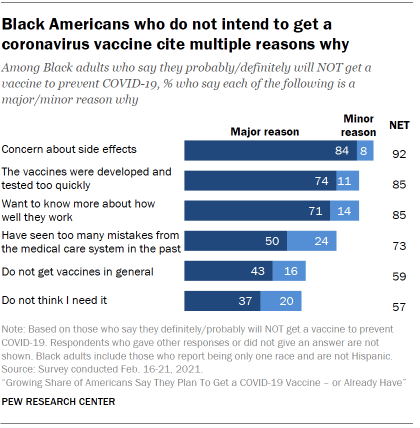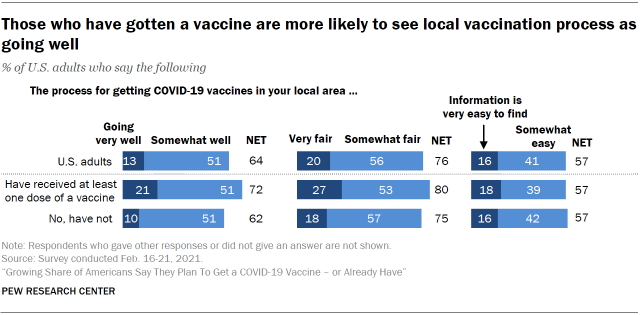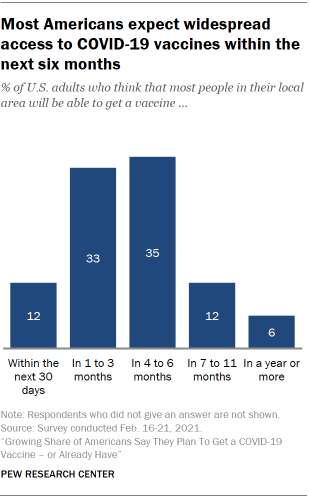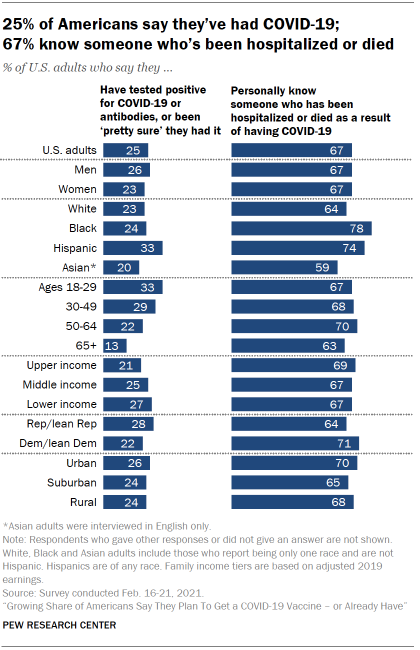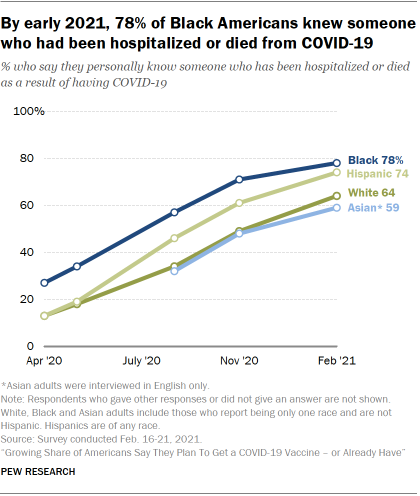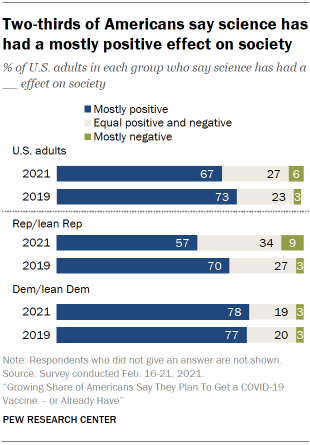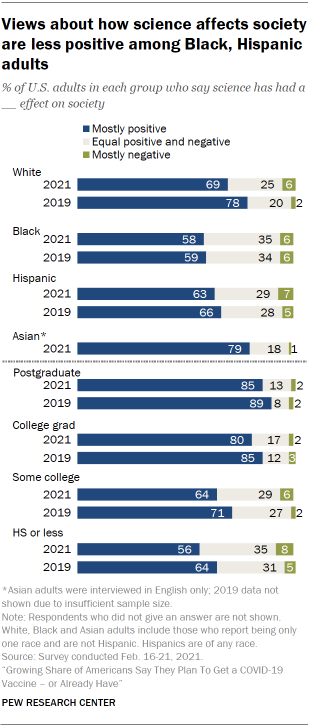77% think vaccinations will benefit U.S. economy
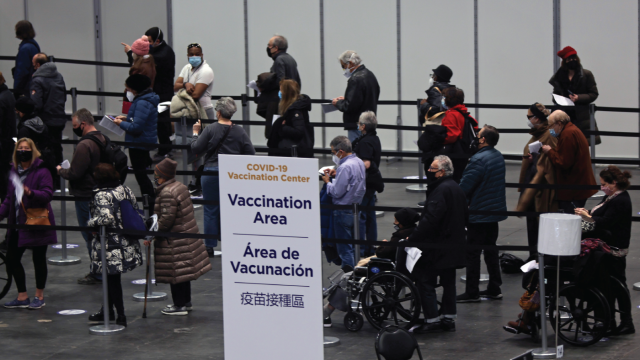
Pew Research Center conducted this study to understand how Americans are continuing to respond to the coronavirus outbreak. For this analysis, we surveyed 10,121 U.S. adults from Feb. 16 to 21, 2021.
Everyone who took part in the survey is a member of the Center’s American Trends Panel (ATP), an online survey panel that is recruited through national, random sampling of residential addresses. This way, nearly all U.S. adults have a chance of selection. The survey is weighted to be representative of the U.S. adult population by gender, race, ethnicity, partisan affiliation, education and other categories. Read more about the ATP’s methodology.
See here to read more about the questions used for this report, along with responses and its methodology.
More than a year after the coronavirus first arrived in the United States, there are signs of growing public dissatisfaction with the country’s response. Performance ratings for how top health and state and local officials have responded to the outbreak continue to decline. And there’s less consensus than there was at the start of the outbreak about whether certain steps, like restrictions on restaurants, are necessary.
Still, at the outset of President Joe Biden’s term, there’s more optimism than pessimism that the policies of his administration will improve the country’s response to the outbreak. There’s also a shared sense that vaccination efforts will play some role in improving the economy – a top public priority.
And, as COVID-19 vaccine production and administration efforts in the U.S. continue to ramp up, a new Pew Research survey finds public intent to get vaccinated is on the rise.
Overall, 19% of adults say they have already received at least one dose of a coronavirus vaccine. Another 50% say they definitely or probably plan to get vaccinated. Taken together, 69% of the public intends to get a vaccine – or already has – up significantly from 60% who said they planned to get vaccinated in November.
Differences across demographic and political groups continue to characterize public views of COVID-19 vaccines. Yet these dynamics are fluid, and there have been some notable changes as intent has risen and vaccines become more widely available in the U.S.
- A majority of Black Americans (61%) now say they plan to get a COVID-19 vaccine or have already received one, up sharply from 42% who said they planned to get vaccinated in November. Differences in intent to be vaccinated among Black, White, Hispanic or Asian adults are generally smaller now than they were three months ago.
- Among older adults – who are at greater risk of a serious case of the disease and have priority access to vaccines in most places – 41% say they have already received at least one dose; another 44% say they definitely or probably plan to get vaccinated. Intent to get vaccinated remains higher among those ages 65 and older than among younger adults.
- People with lower income levels continue to be less inclined than those with higher incomes to get a vaccine, a dynamic that is borne out in the shares who say they have already received a COVID-19 vaccine: 14% of lower-income adults say they have gotten at least one dose of a vaccine, compared with 20% of middle-income adults and 27% of upper-income adults.
- A smaller majority of women (66%) than men (72%) intend to get a vaccine or have already received at least one dose. Among those not planning to get vaccinated, women are more likely than men to cite concerns about the rapid pace of vaccine development and a lack of information about how well they work as major reasons why they don’t plan to get a vaccine.
- Partisan differences, which have long characterized views about the outbreak, are increasingly seen in vaccine intent. Democrats are now 27 percentage points more likely than Republicans to say they plan to get, or have already received, a coronavirus vaccine (83% to 56%). This gap is wider than those seen at multiple points in 2020.
The factors tied to the decision to get a COVID-19 vaccine are complex and interrelated. Center analyses find trust in the vaccine research and development process ties strongly to people’s vaccine attitudes and actions – vaccine intent is 75 points higher among those with high trust than low trust. Those who place a lot of emphasis on community health in the vaccination decision are 60 points more likely than those who give this no consideration to intend to get a vaccine. Habits and practices with the seasonal flu vaccine also closely tie to intent to get vaccinated (there’s a 39-point difference between those who get a flu shot yearly and those who rarely or never do). People’s level of personal concern about getting a serious case of the disease plays a smaller role than it did earlier in the outbreak, as a majority (58%) of those who are not too or not at all concerned about getting a serious case now say they intend to get a vaccine or have already done so (up from 48% in November).
Those who do not currently plan to get a vaccine (30% of the public) list a range of reasons why. Majorities cite concerns about side effects (72%), a sense that vaccines were developed and tested too quickly (67%) and a desire to know more about how well they work (61%) as major reasons why they do not intend to get vaccinated.
Smaller shares of those not planning to get a vaccine say past mistakes by the medical care system (46%) or a sense they don’t need it (42%) are major reasons why they don’t plan to get a vaccine; 36% of this group (11% of all U.S. adults) say a major reason they would pass on receiving a coronavirus vaccine is that they don’t get vaccines generally.
The new national survey by Pew Research Center, conducted Feb. 16 to 21 among 10,121 U.S. adults, finds more positive than negative expectations of how the plans and policies of Joe Biden’s administration will impact the country’s response to the coronavirus outbreak. Overall, 56% think Biden’s policies will make the country’s response better, compared with 20% who think they will make it worse; 24% don’t expect them to make much difference either way.
Strengthening the economy and dealing with the coronavirus sit atop the public’s to-do list for Biden and Congress this year. And, as 81% continue to view the coronavirus outbreak as a major threat to the economy, most Americans see a connection between efforts to vaccinate the public and the strength of the U.S. economy.
About three-quarters say it would help the economy either a lot (51%) or a little (25%) if a large majority of Americans get a vaccine for COVID-19. Democrats and those who lean to the Democratic Party are more likely than Republicans and Republican leaners to say widespread vaccine uptake would help the economy a lot (66% vs. 37%); still, a majority of Republicans say this would help the economy at least a little (66%).
New cases of the coronavirus in the U.S. have declined significantly from their peak earlier this winter, and the number of vaccine doses administered continues to increase. Yet the public expresses a degree of concern when it comes to the new variants of the coronavirus recently discovered around the world: 51% think these variants will lead to a major setback in the country’s efforts to contain the disease. By contrast, 48% do not think new coronavirus variants will have a major impact on the country’s efforts to contain the disease.
Competing perspectives on the outbreak and how best to respond to it
Overall, 63% of the public says the current outbreak is a major threat to the health of the U.S. population as a whole, while the remainder sees the outbreak in less serious terms.
The attitudes of those who view the coronavirus as a major threat to public health and those who say it’s no more than a minor threat present two different perspectives on the state and scope of outbreak.
These two groups differ on most every aspect – from personal concern about getting the disease to opinions about policies aimed at containing its spread.
Among those who say the coronavirus is a major public health threat, concern about personal roles in spreading the disease is relatively high, 79% intend to get a vaccine, or have already received one, and majorities consider a range of policies to address the outbreak as necessary steps.
By contrast, those who view the public health threat posed by the coronavirus outbreak in less serious terms are not particularly concerned about getting the disease themselves. They are divided on whether they plan to get vaccinated; further, while they see some steps to confront the outbreak as necessary (such as requiring masks on airplanes and public transportation), they view others (such as closing K-12 schools for in-person learning) as unnecessary.
Differences in outlook over the seriousness of the public health threat extend to how much individuals should consider the community health impact in their own decision on whether to get vaccinated – those who see the outbreak in the most serious terms are especially likely to say community health impact should factor prominently in the decision to get a vaccine.
One area where the divide between the two groups is relatively modest is direct contact with the disease: 22% of those who view the outbreak as a major public health threat, compared with 29% of those who view it as a minor threat or not a threat, say they’ve tested positive for COVID-19 or been pretty sure they’ve had it.
While partisanship plays a role in these differing perspectives (Republicans are less likely than Democrats to see the outbreak as a major public health threat), there are members of both political parties in either camp and attitudes about the seriousness of the outbreak tie to differing views among both Republicans and Democrats.
These are among the principal findings from Pew Research Center’s latest report on the coronavirus outbreak and Americans’ views of a COVID-19 vaccine. The survey also finds:
Most view early stages of vaccine distribution as going at least somewhat well. Overall, 64% of Americans say the vaccine rollout in their area is going very (13%) or somewhat well (51%). Those who have received a vaccine tend to be more positive in their assessments; 72% of this group say the distribution is going at least somewhat well. As localities grapple with how best to distribute the vaccine, 76% say the process in their area has been very or somewhat fair. A smaller majority (57%) says information about how to get vaccinated in their area has been very or somewhat easy to find.
Support for additional restrictions on public activity declines: 27% say there should be more restrictions on public activity in their area, down from 44% who said this in November. About four-in-ten (41%) now say the number of restrictions in their area should stay about the same, while 31% say there should be fewer restrictions where they live. Republicans – especially those living in places with a statewide mandate to wear masks or other face coverings – express very little support for additional restrictions on public activity.
Black adults stand out for their heightened concern about the coronavirus. Black Americans stand out from other racial and ethnic groups in their levels of concern about the disease: 49% of Black adults consider the disease a major threat to their personal health, compared with 26% of White adults. Black Americans also are among those most concerned about the possibility they might unknowingly spread the disease to others.
A quarter of Americans say they have had the coronavirus; two-thirds know someone who has been hospitalized or who has died from the disease. Underscoring the toll of the pandemic, majorities across all major demographic groups say they personally know someone who has experienced a severe case of COVID-19 or died from the disease.
Positive views of the effects of science on society have edged lower since the pandemic, driven by declining views among Republicans. Two-thirds of U.S. adults say the impact of science on society has been mostly positive, down 6 points from 73% who said this before the pandemic. The share of Republicans and Republican leaners who say the effect of science on society has been positive is down 13 points since 2019 (from 70% to 57%). Among Democrats and Democratic leaners, 78% see the impact of science positively, which is little different from the 77% who said this two years ago.
Public ratings of how top officials have responded to the outbreak have edged downward
More than a year after the U.S. declared a public health emergency due to the coronavirus outbreak, hospitals and medical centers continue to get very positive ratings from the public for their response to the outbreak. By contrast, other groups – including public health officials and state and local elected officials – have seen their ratings decline over the course of the outbreak.
Overall, 85% of the public says hospitals and medical centers in their area have done an excellent or good job responding to the coronavirus outbreak – the most positive rating for any of the six groups or individuals tested in the survey. Assessments of medical centers have changed little over the course of the outbreak.
A somewhat smaller majority (62%) says public health officials, such as those at the Centers for Disease Control and Prevention (CDC), have done an excellent or good job. This rating is down 5 points since November and much lower than the 79% who gave public health officials positive ratings during the early stages of the outbreak in March 2020.
When it comes to elected leaders, 55% give local elected officials excellent or good ratings for their response to the coronavirus outbreak, and about half (49%) say this about their state elected officials. Positive ratings of both groups have declined significantly over the course of the outbreak.
At the outset of his administration, a narrow majority (54%) says Joe Biden is doing an excellent or good job responding to the outbreak. By contrast, a smaller share (36%) rates the job his predecessor Donald Trump did responding to the outbreak during his time in office as excellent or good.
Large majorities of Democrats (including those who lean to the Democratic Party) and Republicans (including Republican leaners) say hospitals and medical centers in their area have done an excellent or good job responding to the coronavirus outbreak (88% and 83%, respectively). Other assessments of top officials are far more partisan.
Democrats are more likely than Republicans to rate the performance of public health officials positively (79% vs. 44%). Excellent or good ratings of health officials among Republicans are down 14 points since November, while views among Democrats have stayed about the same.
Similarly, Democrats are 12 points more likely than Republicans to say their local elected officials have done an excellent or good job responding to the outbreak (60% vs. 48%) and 16 points more likely to rate the performance of state elected officials positively (57% to 41%). In both cases, ratings among Republicans are lower than they were three months ago.
The widest partisan gaps are seen in performance ratings of Joe Biden and Donald Trump. A large majority (84%) of Democrats say Biden is doing an excellent or good job responding to the coronavirus outbreak; by contrast, just 20% of Republicans say this. The partisan gap is equally wide in assessing the job Donald Trump did responding to the outbreak during his time in office, though Trump gets slightly less positive ratings than Biden from members of his own party (71% of Republicans say Trump did an excellent or good job).
Asked specifically about the plans and policies of the Biden administration to deal with the outbreak, a majority are optimistic: 56% think the administration will make the country’s response to the coronavirus outbreak a lot or a little better, while just 20% think it will make it a lot or a little worse (24% don’t think it will make much of a difference either way).
Nearly nine-in-ten Democrats (87%) expect the Biden administration’s policies to improve the country’s response to the coronavirus outbreak. Views among Republicans are more mixed: 42% think they will worsen the country’s response to the outbreak, while 38% think they won’t change it much, and 19% think they will make the country’s response better.
With the job market still recovering from the surge in unemployment last spring, 81% of Americans continue to view the coronavirus outbreak as a major threat to the U.S. economy. As has been the case for most of the past year, a smaller majority (63%) views the outbreak as a major threat to public health.
Republicans and Democrats remain far apart in their assessments of the nature of the public health threat posed by the coronavirus. Views today are as divided as they have been at any point in the outbreak: 82% of Democrats and Democratic leaners say the coronavirus outbreak is a major threat to the health of the U.S. population as a whole; half as many Republicans and Republican leaners (41%) say the same.
By contrast, comparable majorities of Democrats (83%) and Republicans (81%) continue to view the coronavirus outbreak as a major threat to the U.S. economy.
Americans are divided over whether closing K-12 schools to in-person learning is necessary to address the coronavirus outbreak
Large majorities of Americans say requiring face masks for travelers, restricting international travel to the U.S. and asking people to avoid gathering in large groups are necessary steps to help address the coronavirus outbreak. Overall, 85% say requiring masks or face coverings for travelers on airplanes and public transportation is necessary. About eight-in-ten (79%) adults think restricting international travel to the U.S. is necessary, and 76% say asking people to avoid gathering in large groups is necessary.
Americans are divided over whether limiting restaurants to carry-out only and closing K-12 schools for in-person learning are needed steps. Half think limiting restaurants to carry-out only is necessary, and a slightly smaller share (47%) say closing K-12 schools for in-person learning is necessary.
Majorities of Democrats and Republicans say requiring face masks for travel, restricting international travel and asking people to avoid gathering in large groups are necessary steps to control the outbreak. However, in all three cases, larger majorities of Democrats than Republicans express this view. The gap is particularly wide when it comes to asking people to avoid gathering in large groups: 93% of Democrats view this as necessary compared with 56% of Republicans.
Democrats and Republicans disagree over whether closing K-12 schools for in-person learning and limiting restaurants to carry-out only are needed to control the outbreak. Two-thirds of Democrats say closing K-12 schools for in-person learning is necessary; just 25% of Republicans say the same. Democrats are also far more likely than Republicans to say limiting restaurants to carry-out is necessary (74% vs. 23%).
These wide partisan divides stand in contrast to last March at the start of the coronavirus pandemic, when large majorities of Democrats and Republicans agreed that policies such as limiting the size of in-person gatherings, restricting restaurants to carry-out only and closing K-12 schools were necessary to address the coronavirus outbreak.
Those who view the coronavirus as a major threat to public health are more likely than those who see it as less of a threat to view each of the five policies tested in the survey as necessary. Still, majorities of both groups say face masks for travelers and limiting international travel are necessary steps.
Public support for more coronavirus restrictions has tapered off since November
In the new survey, about four-in-ten Americans (41%) say limits on public activity in their area due to the coronavirus outbreak should stay about the same as they are now, while 31% say there should be fewer restrictions, and 27% think there should be more restrictions.
There is less public appetite for restrictions compared with just a few months earlier. The 27% who say there should be more restrictions where they live is down from 44% who said this in November. At the same time, there has been a rise in the share who say there should be fewer restrictions where they live: from 21% in November to 31% now.
There continue to be large political differences in views about restrictions on public activity. Most Democrats think there should either be about the same number (48%) or more (41%) restrictions on public activity in their area. In contrast, a slight majority of Republicans (56%) thinks there should be fewer restrictions, and 32% say there should be about the same number of restrictions.
Opinions about limits on public activity vary depending on the nature of restrictions already in place. One way to capture such variation is to analyze places with and without a mandate to wear a mask or other face covering when in public spaces.
People living in states without a mask mandate are more supportive of additional restrictions on public activity than those in places that currently have a mask mandate (35% vs. 25%). At the time of the survey, 35 states and the District of Columbia had a statewide mandate for wearing masks or face coverings in indoor public spaces and 15 states did not.
This difference is especially pronounced among Democrats. A 57% majority of Democrats living in places without a statewide mask mandate favor more restrictions on public activity in their area. In comparison, 36% of Democrats in states with a mask mandate say there should be more restrictions.
People who live in states with a mask mandate are more likely than those who live in states without a mandate to say there should be fewer restrictions. Among Republicans, six-in-ten of those living in areas with a statewide mask mandate say there should be fewer restrictions on public activity where they live, compared with 45% of those who live in states without a mandate.
Regardless of people’s views about restrictions, a large majority of Americans report regularly wearing a face mask or covering in public. About nine-in-ten U.S. adults (88%) say they have worn a mask all or most of the time in stores and businesses over the past month, a nearly identical share as in November. Most Democrats and Republicans say they wear a mask in public regularly. More than nine-in-ten Democrats (93%) and more than eight-in-ten Republicans (83%) report wearing a mask in public all or most of the time.
About three-quarters of Americans see link between vaccination efforts and economic improvement
Strengthening the economy and dealing with the coronavirus outbreak rank atop the public’s list of policy priorities for the president and Congress this year. And most Americans believe efforts to slow the spread of the disease through widespread vaccinations will improve the economy.
About three-quarters say that a large majority of Americans getting a vaccine for COVID-19 would help the U.S. economy either a lot (51%) or a little (25%). Just 22% think widespread vaccine uptake would not make much of a difference for the economy.
Most Democrats say getting a large majority of Americans vaccinated will help the economy either a lot (66%) or a little (21%). This view is less widely held among Republicans; still, 66% think widespread vaccinations would help the economy at least a little. Partisans have disagreed about the best ways to help the economy during the outbreak; last August, Democrats were significantly more likely than Republicans to say reducing the number of infections – rather than easing restrictions on stores and schools – was the more effective way to help the economy recover.
About half expect coronavirus variants to lead to major setback for U.S.
As new – and potentially more infectious – coronavirus variants have been identified around the world, 51% of Americans expect these variants to lead to a major setback for the country’s efforts to contain the disease. About as many (48%) do not.
A majority (62%) of those who view the outbreak as a major threat to public health say they think new variants of the coronavirus will lead to a setback for U.S. efforts to contain the disease. By contrast, 68% of those who call the coronavirus outbreak a minor threat or not a threat to public health think the new variants won’t have a major impact on the country.
Consistent with differing levels of concern about the outbreak, a larger share of Democrats (60%) than Republicans (40%) say new coronavirus variants will cause a major setback for the country.
When it comes to the impact of new coronavirus variants on vaccination efforts in the U.S., 58% of Americans say that these variants make getting a large majority of Americans vaccinated more important. About a third (32%) say the variants don’t change their views on the importance of vaccination efforts; 8% say they make these efforts less important.
Attitudes about new coronavirus variants and the importance of vaccinations in the U.S. are closely tied to perceptions of the threat posed by the outbreak.
Nearly three-quarters (73%) of those who see that outbreak as a major threat to public health say the new variants make it more important for a large majority of Americans to get vaccinated for the disease. By contrast, just 33% of those who view the outbreak as a less serious threat to public health say the same.
Three-quarters of Democrats say new variants make it more important for a large majority of Americans to get vaccinated for the coronavirus. Among Republicans, 48% say the new variants do not change their views, while 41% say they make widespread vaccinations more important.
Two-thirds tilt against a U.S. role in helping developing countries access coronavirus vaccines if it would delay Americans’ access
With global demand for COVID-19 vaccines outpacing supply, many developing nations around the world have yet to begin widespread vaccination efforts.
Asked to consider the U.S. role in global vaccine distribution, 66% of Americans say the country should ensure that there are enough coronavirus vaccines for people in the U.S., even if it means people in developing countries need to wait longer to get vaccines. Fewer (30%) say the U.S. should help ensure that people in developing countries have access to coronavirus vaccines, even if it means some people in the U.S. need to wait longer to get vaccines.
About three-quarters of Republicans (77%) say the U.S. should ensure enough vaccine supply for people in the country, even if those in developing countries need to wait longer. A smaller majority of Democrats (58%) also take this view.
Rising shares in U.S. plan to get a COVID-19 vaccine or have already received at least one vaccine dose
Amid efforts to ramp up vaccine production and administration in the U.S., 19% of adults say they have already received at least one dose of a vaccine to prevent COVID-19.
About four-in-ten adults ages 65 and older (41%) say they’ve already received a vaccine for the coronavirus, far higher than the shares of younger adults who say this. Older adults are at a greater risk of experiencing severe cases from the coronavirus and have been given priority access to the vaccine in most places around the country.
Among those ages 65 and older, upper-income seniors (57%) are more likely than middle-income (42%) or lower-income (24%) seniors to say they have received at least one dose of a coronavirus vaccine.
Consistent with partisan differences in concern about vaccines measured over the course of the outbreak, a larger share of Democrats (48%) than Republicans (36%) ages 65 and older say they have received a vaccine for COVID-19.
Across community types, seniors in rural areas are 9 points less likely than those in suburban and urban areas to have received a vaccine.
Differences by race and ethnicity in vaccine intent narrow; those by political party widen
In addition to the 19% of adults who have already received a coronavirus vaccine, 50% say they definitely or probably will get vaccinated.
Taken together, about seven-in-ten Americans (69%) now plan to get a vaccine for COVID-19 or have already received at least one dose, up from 60% who said they planned to get vaccinated in November.
The increase in intent to get a coronavirus vaccine can be seen across most demographic groups, though sizable differences remain.
A majority of Black adults (61%) now say they plan to get vaccinated or already have, up 19 points from November when 42% said they planned to get vaccinated. While vaccine intent has also increased among White, Hispanic and Asian adults, the increase among Black adults is especially pronounced. In November, White adults were 19 points more likely than Black adults to say they would get vaccinated; today, the gap in the shares who intend to get vaccinated, or already have been, is 8 points.
A large majority of Democrats and Democratic leaners (83%) intend to get vaccinated or have already received a vaccine, up 14 points since November. There has been a more modest 6-point increase among Republicans and Republican leaners (from 50% to 56%). As a result, the partisan gap has grown from 19 points in November to 27 points in the current survey.
Other demographic patterns seen earlier in the outbreak persist in the current survey. Those with higher levels of education and income continue to be more likely than those with lower levels of education and income to say they plan to get a vaccine or have already received one. The oldest Americans are much more likely than younger Americans to say they’ve received a vaccine or intend to get one, and men remain more likely than women to say this.
Across community types, those in suburban (73%) and urban (70%) areas are more likely than those in rural areas (60%) to say they have been, or plan to get, vaccinated for the coronavirus.
While a majority of Americans intend to get vaccinated, three-in-ten say they will probably (15%) or definitely (15%) not get a vaccine for the coronavirus.
When asked why they feel this way, 72% of this group cite concern about side effects as a major reason they don’t plan to get vaccinated, and another 17% call this a minor reason.
Concern that the vaccines were developed and tested too quickly (67% major reason) and wanting to know more about how well they work (61% major reason) are also top reasons mentioned by those not planning to get vaccinate.
About four-in-ten of those not planning to get vaccinated (42%) say the feeling that they don’t need it is a major reason for their decision. This view differs little across age groups but is more common among those see the outbreak as posing little or no threat to public health.
Among those who don’t intend to get vaccinated, 36% – or 11% of the general public – cite the fact that they don’t get vaccines in general as a major reason why they don’t plan to get a COVID-19 vaccine. Another 22% of this group (7% of the public) call this a minor reason.
Trust in R&D process closely tied to vaccine intent; most Americans think community impact should factor into individual decision on vaccine
High confidence in the vaccine research and development process goes hand-in-hand with intent to get vaccinated for the coronavirus.
Almost all (96%) of those with a great deal of confidence in the research and development process say they plan to get a vaccine for COVID-19 or have already received one. A smaller majority of those with a fair amount of confidence in the R&D process also say this. By contrast, a majority (77%) of those with not too much or no confidence in how the vaccines were developed say they will not get vaccinated.
People’s habits around a seasonal flu vaccine also tie in with their intentions to get a COVID-19 vaccine. Large majorities of those who report getting a flu shot every year (86%) or every few years (77%) will get a COVID-19 vaccine or have already done so. Among those who rarely or never get a flu shot, 51% say they don’t plan to get vaccinated for the coronavirus.
Nine-in-ten adults say people should consider the health effects for the community either a lot (63%) or a little (27%) when making their own decision about whether to get a COVID-19 vaccine. Just 9% say the community impact should not be a consideration.
Those who have already received a vaccine (79%) or plan to get one (75%) are much more likely than those who do not plan to get a vaccine (34%) to say community impact should factor a lot in an individual’s decision about whether to get vaccinated.
There is a similar pattern by levels of concern about contracting COVID-19: Those with higher levels of concern are more likely than those with lower levels of concern to say community impact should be a factor in a person’s decision about whether or not to get vaccinated.
There also is a wide gap on this question by partisanship: Nearly eight-in-ten Democrats and Democratic leaners (79%) think people should consider the health effects for the community a lot in making their decision about whether to get a COVID-19 vaccine, compared with 47% of Republicans and Republican leaners.
Black Americans often more concerned about coronavirus, but smaller shares say they will get or already have gotten a vaccine
Black Americans have been hit disproportionately hard by the coronavirus outbreak. Since the beginning of the pandemic, they have been more likely than other racial or ethnic groups to die or be hospitalized as a result of contracting COVID-19. A recent CDC analysis found Black life expectancy in the U.S. has fallen by 2.7 years from its pre-pandemic levels, a somber illustration of the toll of the pandemic.
The new Center survey finds about eight-in-ten Black adults (78%) say they personally know someone who has been hospitalized or who died as a result of contracting COVID-19. About half (49%) describe the outbreak as a “major threat” to their personal health, higher than that for the population overall in comparison. About one-third of Black adults (35%) are very concerned that they themselves will get the coronavirus and require hospitalization, compared with 21% of the overall population. (See Appendix A for comparisons on these questions across racial and ethnic groups.)
Previous Center surveys found that Black adults have followed news about COVID-19 more closely than the overall population and discussed the outbreak with others more frequently than other racial or ethnic groups.
The majority of Black adults see the emergence of new, more contagious coronavirus variants as a likely setback in the U.S.’s efforts to contain the virus; about seven-in-ten (68%) think these new variants will lead to a major setback in efforts to contain the virus, compared with about half of adults overall (51%).
Black adults are more likely than White adults to say they are very concerned about unknowingly spreading the disease to others (42% vs. 23%); overall, 30% of U.S. adults say they are very concerned about this. And while a large majority of U.S. adults (88%) say they have worn a mask in stores or businesses all or most of the time over the past month, the share of Black adults (94%) who say they’ve done this is even higher.
At the same time, Black Americans stand out for being less likely than other groups to say they will get vaccinated. Overall, 61% of Black Americans say they will definitely or probably get a COVID-19 vaccine (47%) or that they have already received at least one dose (15%). Larger majorities of White (69%), Hispanic (70%) and English-speaking Asian (91%) adults say they will get a vaccine or have already done so.
Among Black Americans, older adults are more inclined than younger adults to say they would get a coronavirus vaccine. A larger share of Black men than women say they would get a coronavirus vaccine, or that they have already done so. Both patterns parallel age and gender differences seen in the overall population.
One of the strongest predictors of Black adults’ intention to be vaccinated stems from their levels of trust in the vaccine research and development process. In the new survey, 24% of Black Americans say they have a great deal of confidence that the research and development process has produced safe and effective vaccines, 42% have a fair amount of confidence in this process and 34% have not too much confidence or none at all.
Among the 24% of Black Americans who have a great deal of confidence in the research and development process for vaccines, 89% intend to get a coronavirus vaccine or have already received at least one dose. By contrast, among the 34% of Black Americans with low trust in the vaccine R&D process, just 26% say they will get a vaccine or have already done so; 72% say they will not.
Among Black adults who say they definitely or probably will not get a coronavirus vaccine, large shares say major reasons why include concern about side effects (84%), thinking the vaccines were developed and tested too quickly (74%) and wanting to know more about how well they work (71%). Half of Black Americans who do not intend to get a vaccine say a major reason is because they have seen too many mistakes from the medical care system in the past; 43% say they do not get vaccines in general, and 37% say they don’t think they need the vaccine.
Majority of U.S. adults see local administration of vaccine in positive light
Overall, a majority of U.S. adults (64%) say that the process for getting COVID-19 vaccines in their local area is going at least somewhat well, though just 13% describe it as going “very” well. About a third (34%) say the process is going not too or not at all well.
As local jurisdictions have grappled with questions about who should be first in line to receive a vaccine, 76% of the public describes the process for getting a COVID-19 vaccine in their local area as either very or somewhat fair. A smaller majority (57%) says it’s very or somewhat easy to find information about how to sign up for a vaccine in their area; 41% describe this information as not too easy or not at all easy to find.
While there are often wide partisan and demographic differences in levels of concern about the outbreak and aspects of coronavirus policy, local assessments of the vaccine rollout vary only modestly by political party or demographic groups (see Appendix A for more details).
Those who have experienced the vaccination process are more likely than those who have not been vaccinated to say the process in their area is going well (72% vs. 62%). Views on the fairness of the vaccination process and ease of finding information about it are little different by vaccination status.
Most Americans expect there to be widespread access to coronavirus vaccines in their local area in the next six months, though people vary in their expectations over exactly when supply will meet demand. Overall, 35% think most people in their area will be able to get a vaccine in four to six months; almost as many (33%) forecast a quicker timeline and expect this level of availability in one to three months, and 12% think it will be even faster. Still, nearly one-in-five Americans see a much longer timeline: 12% expect it to take seven to 11 months until there is widespread availability, and 6% say this will take a year or more.
A quarter of Americans have had COVID-19
About a year into the outbreak in the U.S., a quarter of adults say they have tested positive for COVID-19 or been “pretty sure” they have had it despite not receiving an official diagnosis. This includes people who tested positive for an active viral infection as well as those tested positive for antibodies (a sign of past infection).
In general, the shares of adults who say they have had COVID-19 are comparable across most demographic groups, though there are some differences.
Hispanic adults (33%) are more likely than Black (24%), White (23%) or Asian (20%) adults to say they have had the coronavirus.
Across age groups, younger adults are more likely than older adults to say they’ve tested positive for the virus or antibodies or been pretty sure they’ve had it.
While views on coronavirus policy are highly linked with partisanship, there is only a modest difference by political party on this measure of personal experience. Republicans and those who lean to the Republican Party (28%) are 6 percentage points more likely than Democrats and Democratic leaners (22%) to say they have had the coronavirus.
Of those who are at least pretty sure they have had COVID-19, a majority (61%) say they have had either mild or no symptoms; 31% describe their symptoms as moderate, and just 8% characterize them as having been severe.
The number of coronavirus deaths in the U.S. has surpassed 500,000. Underscoring the toll of the outbreak, two-thirds of Americans (67%) now say that they personally know someone who has been hospitalized or died as result of having the coronavirus, up from 54% in November 2020. The share saying this has gone up in each Pew Research Center survey conducted since April 2020.
Majorities across demographic groups say they know someone who has been hospitalized or died as a result of having COVID-19. Black (78%) and Hispanic (74%) Americans are especially likely to say this; smaller majorities of White (64%) and Asian (59%) Americans report knowing someone who has been hospitalized or died due to COVID-19.
A majority of adults see positive effects of science on society, but partisan differences have widened since before the pandemic
Two-thirds of Americans now say science has had a mostly positive effect on society, while only 6% say science has had a mostly negative effect, and 27% say science has had mixed effects, about equally positive and negative, on society.
The share of Americans who think science has had a mostly positive effect on society is down 6 percentage points from January 2019, prior to the pandemic. This decrease has largely come from Republicans. Among Republicans and Republican leaners, 57% now say science has had a mostly positive effect on society, down from 70% who said this in January 2019. Among Democrats and Democratic leaners, similar shares in 2021 (78%) and 2019 (77%) said science has had a positive effect.
A November 2020 Center survey also found widening political divides in public trust in scientists. Democrats were 33 percentage points more likely than Republicans to say they have a great deal of confidence in scientists to act in the public’s best interest – a gap that had also grown since the start of the coronavirus outbreak.
Asian adults surveyed are especially likely to say science has had a mostly positive effect on society (79%). (The sample includes English-speaking Asian Americans only.) White adults (69%) continue to be more likely than Hispanic adults (63%) and Black adults (58%) to see the effects of science on society in positive terms.
Among Black and Hispanic adults, opinions on this question are roughly the same as in 2019. The share of White adults who say science has had a positive effect on society has declined by 9 percentage points since before the pandemic in 2019 (from 78% in 2019 to 69% in the new survey); the decline is primarily among White adults who are Republicans or lean to the GOP.
There continue to be large differences by educational attainment in views about science. More than eight-in-ten Americans with a postgraduate degree (85%) and 80% of those with a college degree say science has had a mostly positive effect on society. In contrast, 56% of adults with a high school diploma or less think science has had a positive effect. There are similar differences by education among both Republicans and Democrats.
